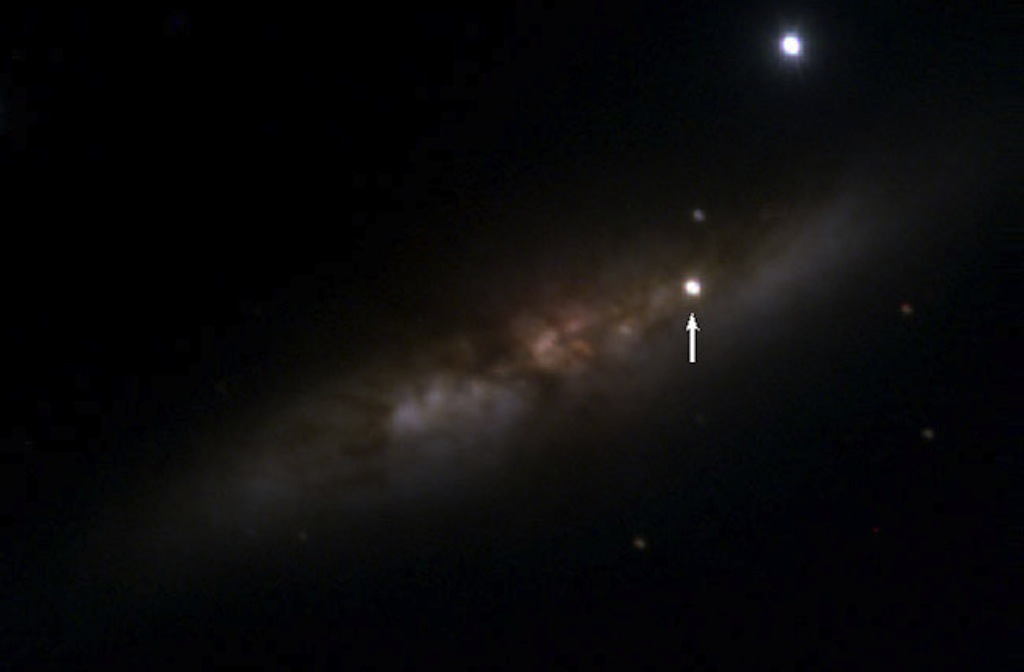SN 2014J Oddball: Nearby Supernova Is a Bit Weird

The now-famous supernova that erupted in neighboring galaxy M82 last month is a unique opportunity to study an exploding star up-close. However, SN 2014J isn’t any old supernova, it turns out that it’s a little bit weird.
Discovered by a team of UK astronomy students on Jan. 21, the brightening SN 2014J was quickly identified as a Type 1a supernova. This particular type of supernova is critical to astronomers as they generate a specific amount of energy. They are used as “standard candles” as a means to measure the size of the Universe and the accelerated rate that the Cosmos is expanding. Observations of Type 1a supernovae led to the paradigm-shifting discovery of a mysterious force, known as dark energy, that is driving this expansion.
BIG PIC: Hubble Zooms in on Historic Supernova SN 2014J
Type 1a supernovae aren’t triggered by the core collapse of a massive star, however; they are spawned by white dwarfs — the small, compact stellar husks of dead stars that were approximately a similar mass to our sun — stripping gas from a binary partner. Once the amount of gas reaches a certain threshold, the white dwarf (plus gas) explodes as a supernova.
Although the supernova was spotted on Jan. 21, that wasn’t the time the supernova was triggered. Using observational data from the Katzman Automatic Imaging Telescope (KAIT) at Lick Observatory near San Jose, Calif., astronomer Alex Filippenko (of the University of California, Berkeley) and his team searched earlier images of M82. Luckily, they found an observation that was taken on Jan. 14, only 36 hours after the supernova was initiated. Also, an amateur astronomer in Japan had a chance observation of M82 before it was officially recognized.
Finding these ‘pre-discovery’ observations are an obvious boon to our understanding of the mechanisms at play in a Type 1a supernova in its early stages, but they have also highlighted a puzzle.
Weird is the New Normal?
Get the Space.com Newsletter
Breaking space news, the latest updates on rocket launches, skywatching events and more!
It turns out that SN 2014J had some unusual characteristics. It brightened faster than theoretical models predicted and, according to a Berkeley press release, exhibited the same rapid brightening as another supernova KAIT discovered in 2013. Another recently-observed Type 1a supernova, called SN 2011FE, did not exhibit this rapid brightening, however, but is considered to be a “normal” Type 1a supernova.
GALLERY: The Supercomputer Supernova
“Now, two of the three most recent and best-observed Type Ia supernovae are weird, giving us new clues to how stars explode,” said Filippenko. “This may be teaching us something general about Type Ia supernovae that theorists need to understand. Maybe what we think of as ‘normal’ behavior for these supernovae is actually unusual, and this weird behavior is the new normal.”
In an effort to better grasp what is going on in the early stages of Type 1a supernovae, effort is being spent on surveying the skies more often so the early signals of these stellar explosions can be detected. New survey telescopes, such as the Palomar Transient Factor in San Diego County and the Pan-STARRS in Hawaii, are continually scanning the skies to detect more of them.
“Very, very early observations give us the most stringent constraints on what the star’s behavior really is in the first stages of the explosion, rather than just relying on theoretical speculation or extrapolating back from observations at later times, which is like observing adolescents to understand early childhood,” said Filippenko.
Refining our understanding on how these “weird” Type 1a supernovae work do not contradict the groundbreaking discoveries on the scale of the universe, it’s expansion or the discovery of dark energy, but it may help to refine our knowledge of these discoveries, providing a more precise understanding of the “standard candles” that occasionally brighten galaxies.
This research will be published in The Astrophysical Journal Letters on March 1.
This story was provided by Discovery News.
Join our Space Forums to keep talking space on the latest missions, night sky and more! And if you have a news tip, correction or comment, let us know at: community@space.com.
Ian O'Neill is a media relations specialist at NASA's Jet Propulsion Laboratory (JPL) in Southern California. Prior to joining JPL, he served as editor for the Astronomical Society of the Pacific‘s Mercury magazine and Mercury Online and contributed articles to a number of other publications, including Space.com, Space.com, Live Science, HISTORY.com, Scientific American. Ian holds a Ph.D in solar physics and a master's degree in planetary and space physics.
